|
1D element
1D element is an element that is made up of 2(primary) or 3(secondary) nodes and has the geometric property of length. Because 3D shapes are expressed as 1D elements, the section (size, shape) needs to be defined and this is modeled as a 2D element for calculations.
FEA NX provides various shapes, as shown in the figure below. The position can also be set when defining the sectional properties.
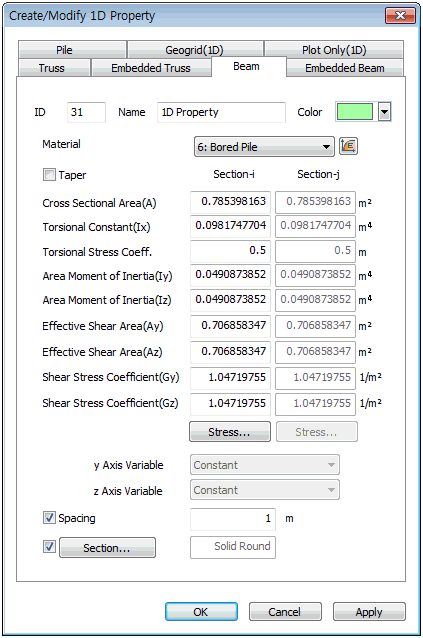
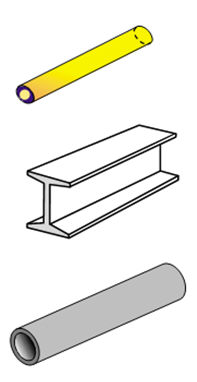 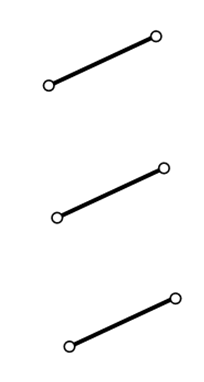
<Actual model> <Finite element model>
|

QUAD-4 6400개
<Solid square>
|
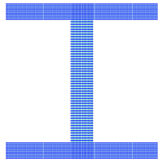
QUAD-4 3400개
<H section>
|
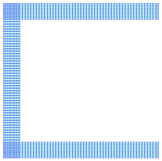
QUAD-4 1700개
<Channel>
|
<Automatic section modeling >
|
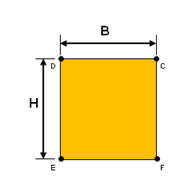
<Solid Rectangle>
|
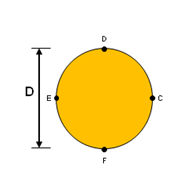
<Solid Round>
|
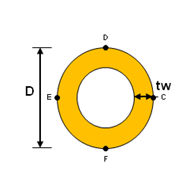
<Pipe>
|
|
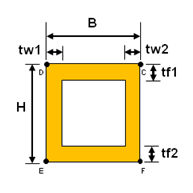
<Box>
|
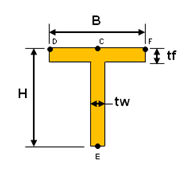
<T-section>
|
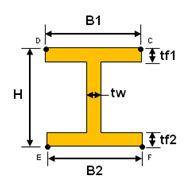
<H-section>
|
|
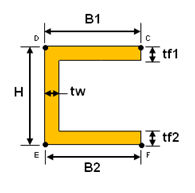
<Channel>
|
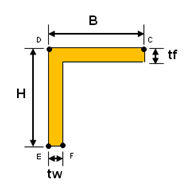
<Angle>
|
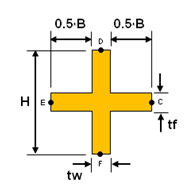
<Cross>
|
|
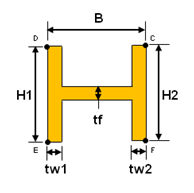
<I-section>
|
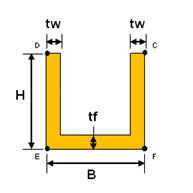
<Channel 1>
|
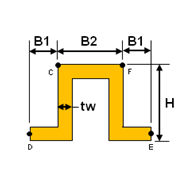
<Hat>
|
<Section shape and size specification>

2D element
2D elements are Triangles or Quadrilaterals with the geometric property of area. Because 3D shapes are expressed as 2D elements, the thickness needs to be defined. The thickness can be set the same or tapered.
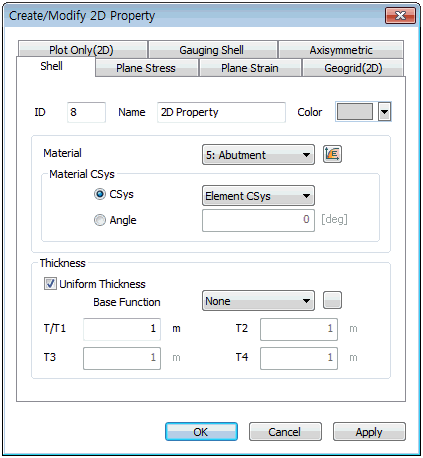
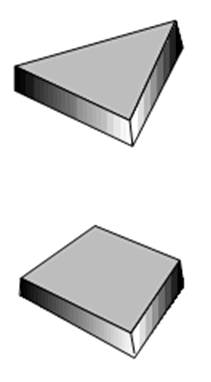 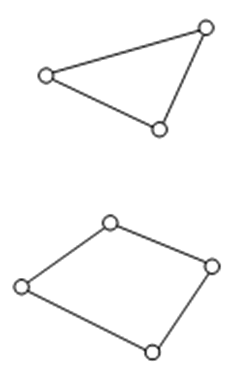
<Actual model> <Finite element model>

3D element
3D elements are Tetrahedron or Hexahedrons, Bricks with the geometric property of volume.
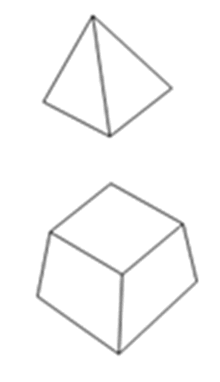 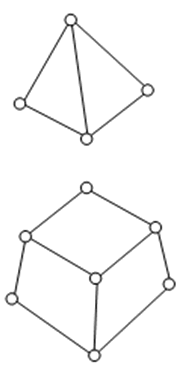
<Actual model> <Finite element model>
Cross sectional area (A)
The cross sectional area is used to calculate the axial stiffness when a tensile or axial force acts on the member or the stress on a member. The calculations for the H section are as follows.
There are 2 methods to calculate the cross sectional area in the FEA NX. The first method uses the provided database to input the dimensions of a section and automatically calculate the area. For the second method, the user calculates the area directly and inputs the value. The first method is convenient, but because it does not consider the decrease in area due to bolts in the connection or rivet holes, the area entered using the second method may provide more accurate results.
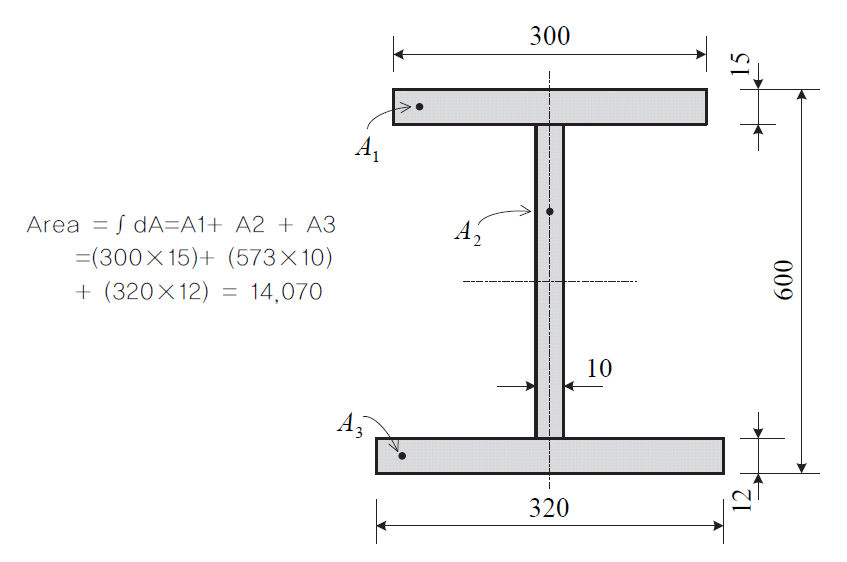
<Example of cross sectional area calculation>

Torsional stiffness (Ixx)
The torsional stiffness resists the torsional moment and is expressed as follows.

Here, : Torsional stiffness, : Torsional stiffness,
 : Torsional moment or torque, : Torsional moment or torque,
 : Torsional angle (angle of twist), : Torsional angle (angle of twist),
 : Shear modulus : Shear modulus
The torsional stiffness is the stiffness that resists the torsional moment and is different from the polar moment of inertia that decides the shear stress due to torsion. (However, the 2 are the same when considering a circular cross-section or a thick cylindrical section)
The torsional stiffness can be calculated from Saint-Venant's principle as shown below.

 is the warping function is the warping function  that can be calculated using the Finite element method as shown below. that can be calculated using the Finite element method as shown below.

Because  , the torsional stiffness comp1nt is expressed as the following equation. , the torsional stiffness comp1nt is expressed as the following equation.


Effective shear area (Asy, Asz )
The effective shear area is needed to calculate the shear stiffness that resists the shear force acting on the y axis or z axis of the element coordinate system. If the effective shear area is not entered, the shear strain in that direction is ignored.

Here,  : Effective shear factor that resists shear force in the y axis of the element coordinate system : Effective shear factor that resists shear force in the y axis of the element coordinate system
 : Effective shear factor that resists shear force in the z axis of the element coordinate system : Effective shear factor that resists shear force in the z axis of the element coordinate system
 : Effective shear area that resists shear force in the y axis of the element coordinate system : Effective shear area that resists shear force in the y axis of the element coordinate system
 : Effective shear area that resists shear force in the z axis of the element coordinate system : Effective shear area that resists shear force in the z axis of the element coordinate system
When the interior section material properties are calculated or entered from the database, the shear stiffness comp1nt is automatically considered and the effective shear factor is calculated using the warping function  from the shear force caused by bending moment and the warping function from the shear force caused by bending moment and the warping function  from the Saint-Venant principle. from the Saint-Venant principle.
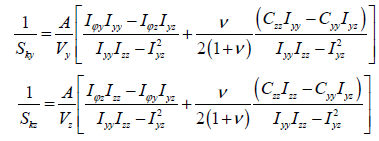
Here,
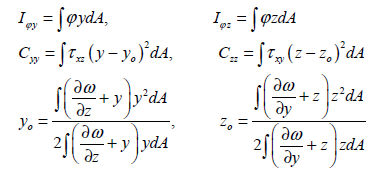

Area moment of inertia (Iyy, Izz)
The area moment of inertia is used to calculate the flexural stiffness that resists the bending moment and is calculated from the centroid axis of the section using the following equation.


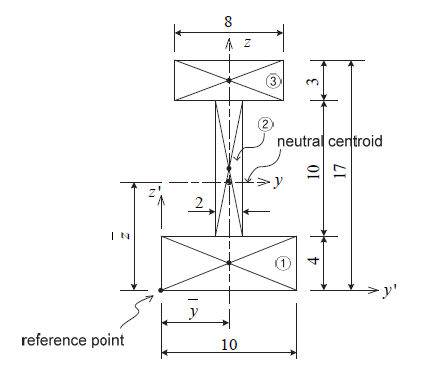
|
Section element
|
b
|
h
|

|

|

|

|

|
|
①
|
10
|
4
|
40
|
2
|
80
|
5
|
200
|
|
②
|
2
|
10
|
20
|
9
|
180
|
5
|
100
|
|
③
|
8
|
3
|
24
|
15.5
|
372
|
5
|
120
|
|
total
|
-
|
-
|
84
|
-
|
632
|
-
|
420
|
<Table. First area moment of inertia and calculation of centroid >
 : area : area
 : distance from the reference point to the centroid of the section element in the z′-axis direction : distance from the reference point to the centroid of the section element in the z′-axis direction
 : distance from the reference point to the centroid of the section element in the y′-axis direction : distance from the reference point to the centroid of the section element in the y′-axis direction
 : first moment of area relative to the reference point in the y′-axis direction : first moment of area relative to the reference point in the y′-axis direction
 : first moment of area relative to the reference point in the z′-axis direction : first moment of area relative to the reference point in the z′-axis direction
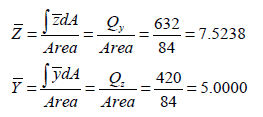
|
Section element
|

|

|

|

|

|

|

|

|

|
|
①
|
40
|
5.5328
|
1224.5
|
53.3
|
1277.8
|
0
|
0
|
333.3
|
333.3
|
|
②
|
20
|
1.4672
|
43.1
|
166.7
|
209.8
|
0
|
0
|
6.7
|
6.7
|
|
③
|
24
|
7.9762
|
1526.9
|
18.0
|
1544.9
|
0
|
0
|
128.0
|
128.0
|
|
total
|
|
2794.5
|
238.0
|
3032.5
|
|
0
|
468.0
|
468.0
|
|
<Table. Second area moment of inertia example>


Area product moment of inertia (Iyz)
The area product moment of inertia is used to calculate the stress comp1nt of an asymmetrical section and the definition is as follows.

H, pipe, box, channel, tee type sections have at least 1 axis of symmetry out of the y,z axis on the element coordinate system and hence Iyz=0. For angle type sections, it does not have any angle of symmetry (Iyz≠ 0) and so, the stress comp1nt needs to be calculated.
The calculations for the area product moment of inertia of an angle type section are shown in the figure below.
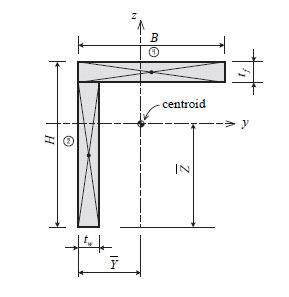 
<Area product moment of inertia calculations for an angle section>

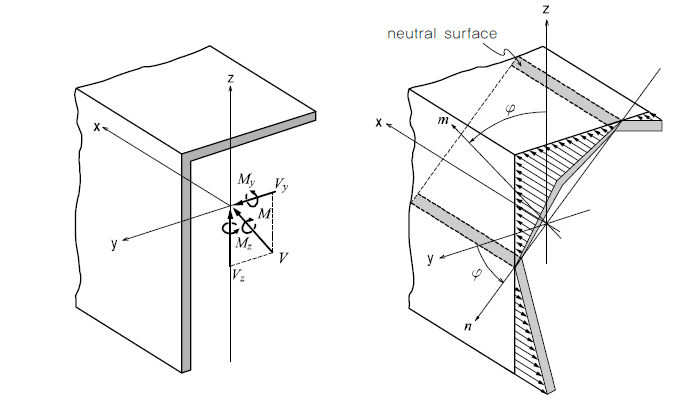
< Flexural stress distribution diagram for asymmetrical section>
The neutral axis is the axis that passes the points where the flexural stress due to the bending moment is ‘0(zero)’ within the member. The neutral axis is perpendicular to the -axis and the -axis.
Because the flexural stress due to bending moment is ‘0’ on the neutral axis, the neutral axis direction can be found by the following equation.

The general equation used to calculate the flexural stress due to bending moment is as follows.

If this is a H type section,  and, and,

Here,  : Second area moment of inertia about the axis of the element coordinate system, : Second area moment of inertia about the axis of the element coordinate system,
 : Second area moment of inertia about the axis of the element coordinate system, : Second area moment of inertia about the axis of the element coordinate system,
 : Area product moment of inertia, : Area product moment of inertia,
 : Elemental axis distance from neutral axis to where the flexural stress is calculated, : Elemental axis distance from neutral axis to where the flexural stress is calculated,
 : Elemental axis distance from neutral axis to where the flexural stress is calculated, : Elemental axis distance from neutral axis to where the flexural stress is calculated,
 : Bending moment about the axis of the element coordinate system, : Bending moment about the axis of the element coordinate system,
 : Bending moment about the axis of the element coordinate system : Bending moment about the axis of the element coordinate system
The shear stress due to shear force acting in the axis and axis direction of the element coordinate system can be calculated using the following equation.

Here,  : Shear force acting in the axis direction of the element coordinate system, : Shear force acting in the axis direction of the element coordinate system,
 : Shear force acting in the axis direction of the element coordinate system, : Shear force acting in the axis direction of the element coordinate system,
 : First area moment of inertia about the axis of the element coordinate system, : First area moment of inertia about the axis of the element coordinate system,
 : First area moment of inertia about the axis of the element coordinate system, : First area moment of inertia about the axis of the element coordinate system,
 : Section thickness at the point where shear stress is calculated in the normal direction to the elemental axis, : Section thickness at the point where shear stress is calculated in the normal direction to the elemental axis,
 : Section thickness at the point where shear stress is calculated in the normal direction to the elemental axis : Section thickness at the point where shear stress is calculated in the normal direction to the elemental axis

First moment of area (Qy, Qz)
The first moment of area is used to calculate the shear stress at an arbitrary point on the section and the shear stress can be calculated using the following equation.

For a section that is symmetrical about the y, z or both axis, the shear strength on an arbitrary point can be calculated using the following equation.
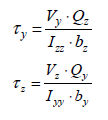
Here, : Shear force acting in the axis direction of the element coordinate system, : Shear force acting in the axis direction of the element coordinate system,
 : Shear force acting in the axis direction of the element coordinate system, : Shear force acting in the axis direction of the element coordinate system,
 : Second area moment of inertia about the axis of the element coordinate system, : Second area moment of inertia about the axis of the element coordinate system,
 : Second area moment of inertia about the axis of the element coordinate system, : Second area moment of inertia about the axis of the element coordinate system,
 : Section thickness at the point where shear stress is calculated in the normal direction to the elemental axis, : Section thickness at the point where shear stress is calculated in the normal direction to the elemental axis,
 : Section thickness at the point where shear stress is calculated in the normal direction to the elemental axis : Section thickness at the point where shear stress is calculated in the normal direction to the elemental axis
Element thickness
On the FEA NX, the thickness needs to be defined to specify the 2D plane stress element, 2D geogrid element, plate element, plane strain element, axial symmetry element, linear interface element etc. Here, the plane strain element, axial symmetry element and linear interface element have an interior unit weight of 1.
The plane stress element, 2D geogrid element and plate element use the thickness value entered by the user. The plate element has a rotor float and because nonlinear analysis is possible, a separate integration is performed in the thickness direction.
Spacing
This functionality is in the 1D element property which is activated only in 2D project setting. Since this option is used to consider the 1D element force per each element when the user introduce the 1D element more or less than one along the axis of horizontal direction (thickness direction) in 2D model.
If the user uncheck the spacing option, on the FEA NX, the spacing will be regarded as Plane Strain Thickness in the analysis setting, meaning that the unit thickness based on the selected unit system.
 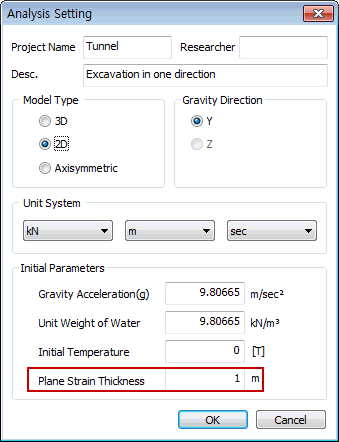
On the FEA NX, spacing is used to calculate the stiffness of the element and output the member force per each element.

where, n = spacing, L = length , A = area, K* = stiffness considering spacing.

where, f* = member force
Refer to the following example,
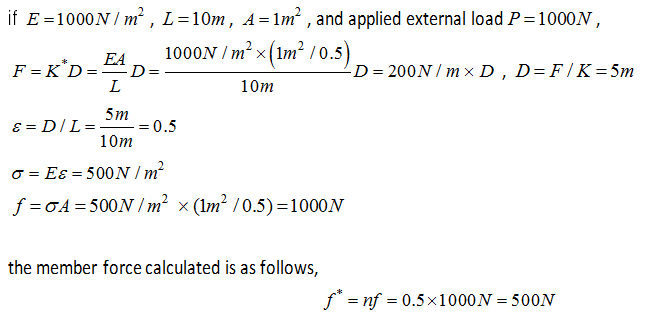
|
